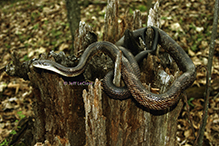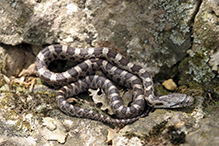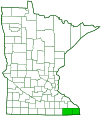Western Ratsnake
(Pantherophis obsoletus)
Conservation • Description • Habitat • Biology • Distribution • Taxonomy
Description |
||
Western ratsnake is a large, nonvenomous, typical snake. It occurs in the central United States west of the Mississippi River from extreme southeastern Minnesota south to Louisiana and central Texas. It is found in a variety of habitats but mostly in forested sites with oak trees, including forested valleys and bluffs, woodland edges, and rock outcrops. In Minnesota there are recent (post 1960) records in just two counties, Houston County and Fillmore County. Western ratsnake is one of the two largest snakes in Minnesota. Adults are usually 42″ to 72″ (106.5 to 183 cm) in length and 1½″ (3.87 cm) at the widest point. The head is wedge-shaped. The body is covered with weekly keeled scales. The middle of the body has 29 or fewer rows of scales. The anal scale is divided. On most adults there are 8 scales along the upper jaw (supralabial scales), more than 220 elongated scales on the underside of the body between the neck and the anal scale (ventral scales), and 70 to 100 scales behind the anal scale (subcaudal scales). Juveniles have a distinct pattern of brown blotches on a gray background. As the snake ages, the color darkens and the blotches become less distinct. Mature adults are almost completely black on the upper side. The top of the head and tail are usually entirely black. The body is mostly black or dark brown, often flecked with white, yellow, orange, or red between the scales. The chin and throat are white or cream-colored. The belly is gray or light brown with dark spots or a checkerboard pattern. |
||
Size |
||
42″ to 72″ (106.5 to 183 cm) |
||
Similar Species |
||
Habitat |
||
Forested valleys and bluffs, woodland edges, rock outcrops |
||
Biology |
||
Behavior |
||
Western ratsnakes are active during the day. They are excellent climbers and spend much of their time in trees. |
||
Lifespan |
||
|
||
Life Cycle |
||
|
||
Food |
||
Birds, bird eggs, rodents, frogs, and invertebrates. |
||
Distribution |
||||
|
Sources |
|||
| 3/25/2023 | ||||
Occurrence |
||||
Rare in Minnesota |
||||
Taxonomy |
|||
| Class | Reptilia (Reptiles) | ||
| Superorder | Lepidosauria | ||
| Order | Squamata (Snakes and Lizards) | ||
| Suborder | Serpentes (Snakes) | ||
| Infraorder | Alethinophidia | ||
| Superfamily | Colubroidea | ||
Family |
Colubridae (Harmless Egg-laying Snakes) | ||
Subfamily |
Colubrinae | ||
Genus |
Pantherophis (North American ratsnakes) | ||
Species A recent mitochondrial DNA analysis (Burbrink et al., 2000) showed the species to be composed of three distinct clades separated by geographical barriers. A later morphological and phylogenetic analysis (Burbrink, 2001) showed that the subspecies were invalid, and proposed raising each clade to full species status. The former subspecies found in Minnesota retained the full species name Elaphe obsoleta. Genus |
|||
Subordinate Taxa |
|||
|
|||
Synonyms |
|||
Coluber obsoletus Elaphe obsoleta Elaphis obsoletus Georgia obsoleta Pituophis obsoletus Scotophis lindheimerii Scotophis obsoletus Spilotes obsoletus |
|||
Common Names |
|||
black snake black rat snake black ratsnake pilot black snake ratsnake Texas rat snake Texas ratsnake western rat snake Western Ratsnake |
|||
Visitor Photos |
|||||
Share your photo of this reptile. |
|||||
| This button not working for you? Simply email us at info@MinnesotaSeasons.com. Attach one or more photos and, if you like, a caption. |
|||||
Jeff LeClere |
|||||
 |
 |
||||
MinnesotaSeasons.com Photos |
|||||
|
|||||

Slideshows |
||

Visitor Videos |
|||
Share your video of this reptile. |
|||
| This button not working for you? Simply email us at info@MinnesotaSeasons.com. Attach a video, a YouTube link, or a cloud storage link. |
|||
Other Videos |
|||
| Hanging Out in the Woods with a Black Rat Snake (Pantherophis obsoletus) Geoffrey Haun |
|||
About
Mar 4, 2023 Me and Rosie the dog hanging out with a black snake under a big maple tree at the edge of the woods. |
|||
| S'N'A Introducing Series: Episode 44 - Black Rat Snakes (Pantherophis obsoletus) Snakes 'N' Adders |
|||
About
Feb 23, 2020 Snakes ‘N’ Adders This is an impressive species of Rat Snake that has been a mainstay of our hobby pretty much since its inception. Black Rat Snakes occupy much of the Northern Central and North Eastern United States. Well they used to. Once again they have been reviewed by scientists and now Black Rat Snakes are restricted to West of the Mississippi River. Previously Black Rat Snakes were the nominate form of the Pantherophis obsoletus complex. Their trinomial name was Pantherophis obsoletus obsoletus. The other subspecies were lindheimeri, spiloides, quadrivittatus & rossalini with the occasional inclusion of williamsi and deckerti. The Black Rat Snake as described by Klaus Dieter Schultz in The monograph of genus elaphe was the Northernmost of the subspecies and spanned from the East coast right across to Western Nebraska and central Kansas. The Northern extreme of their range continues into Canada and the state of Ontario around Lake Huron, Lake Erie and Lake Ontario. Burbrink studied DNA and decided that there was just three species rather than the 5 (sometimes 7) subspecies. An Eastern, Central and Western Race. The Eastern Race including the Yellow and Everglades Rat Snake and all of the Northern Region of the Black Rat Snake would become Alleghaniensis. The central race would take the supspecies name given to the Grey Rat Snake spiloides. Again the central range of the Black Rat Snake would be included here. Then the Texas Rat Snake would no longer exist to science and would be rolled in with the Black Rat Snake to become Pantherophis obsoletus. Shoot. me. now. The hobby still recognises all the subspecies that have been lost or renamed thank god. Of course some like to keep up with the Joneses and use the latest and greatest classification but in truth if people have been breeding a certain group of really nice text book everglades for 20 years TRY telling them they don’t exist. Wholesalers in the UK until recently occasionally brought in animals marked as deckert’s Rat Snakes (Florida Keys Rat Snake). We should continue to breed for type and colour palette that we attribute to the species or subspecies. Black Rat Snakes like Grey and Texas Rat Snakes are born saddled but over time the black pigment increases and takes over making the snake black overall with faint patches and lattices of white interstitial skin roughly indicating where the saddles were. Some are blacker than others. They retain an off white to cream underbelly and chin. So in essence they remain saddled you just can see them. The Yellow and Everglades Rat Snakes both stripe out in adulthood. The record size of a Black Rat Snake is 256cm (8ft 4.5in)!!! – an incredibly length recorded by Ernst & Barbour in 1989. Thankfully the vast majority of Black Rat snakes remain between 5.5-6.5ft. Anything in excess of 7ft would be considered exceptional. The occupy regions from Sea level to 1200m in height and quite obviously can adapt to a number of regions. Lowland deciduous woodland seems to their biome of choice. In captivity Black Rat Snakes are essentially super size Corn Snakes to care for. Their temperature requirements are much the same with a hot end of around 28-30°c. Because of their larger size a minimum vivarium size measuring 48x24x24 will be required. Many keepers may prefer to go larger. Realistically once the snake starts to exceed the size of a Corn Snake heat pads become redundant and a switch to a ceramic heat emitter will be needed. This of course should be controlled by a reliable thermostat preferably with day night control. day time highs for summer months should be 30°c with a night time low of 22-24°c. Substrate can be a number of options including beech or orchid barks, lignocel, aspen or a particulate mix with soil and sands for a more naturalistic feel. Numerous hides and caves should be used along the thermal gradient as well as climbing opportunities. Some keepers will utilise sky cave strapped to the roof of the enclosure to add further enrichment. Just make sure these hides and the logs are over towards the cool side so the snake cannot access temperature in excess of what is recommended. Various pieces of foliage etc can be used to further offer security and investigating opportunities. This is a snake that will use its tank and makes a superb display animal. By using a Shade dweller UVB tube at the basking site it may also encourage the animal out to bath in the rays. This of course is optional. Feeding is rarely if ever an issue and the only time there may be a problem is with males slowing down in winter, in the main they are even more reliable than corn snakes. They will accept mice, rats, gerbils, hamsters, multis, chicks, small quail and quail and hens eggs. Blacks Rat Snakes will usually benefit from Brumation to ensure fertile eggs |
|||
| Black Rat Snake (Pantherophis obsoletus) defensive posture John W |
|||
About
Aug 27, 2015 A short video of a large, adult Black Rat Snake demonstrating defensive behavior and cruising away on the forest floor in Wake County, North Carolina. |
|||

Created: 3/25/2023
Last Updated:



